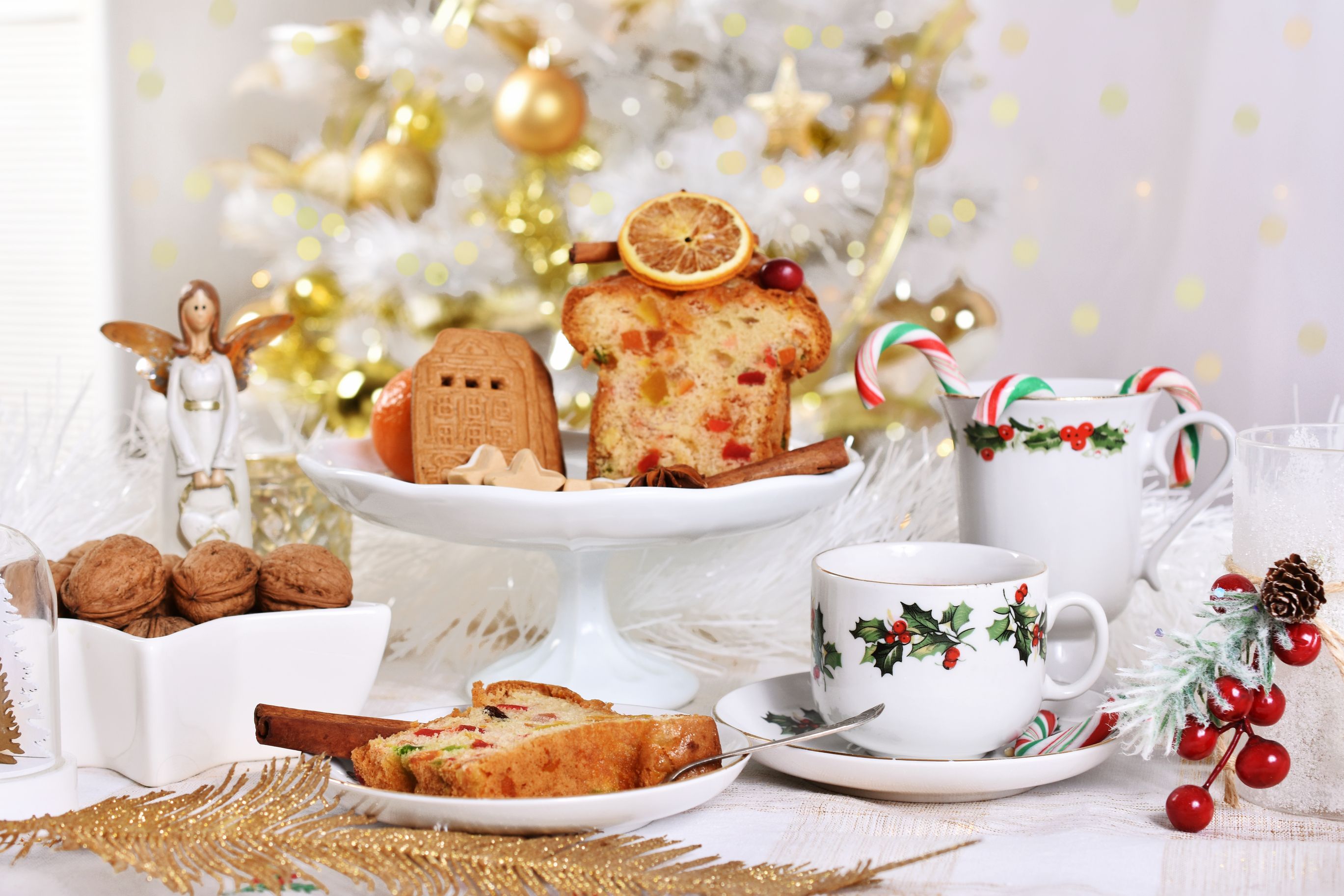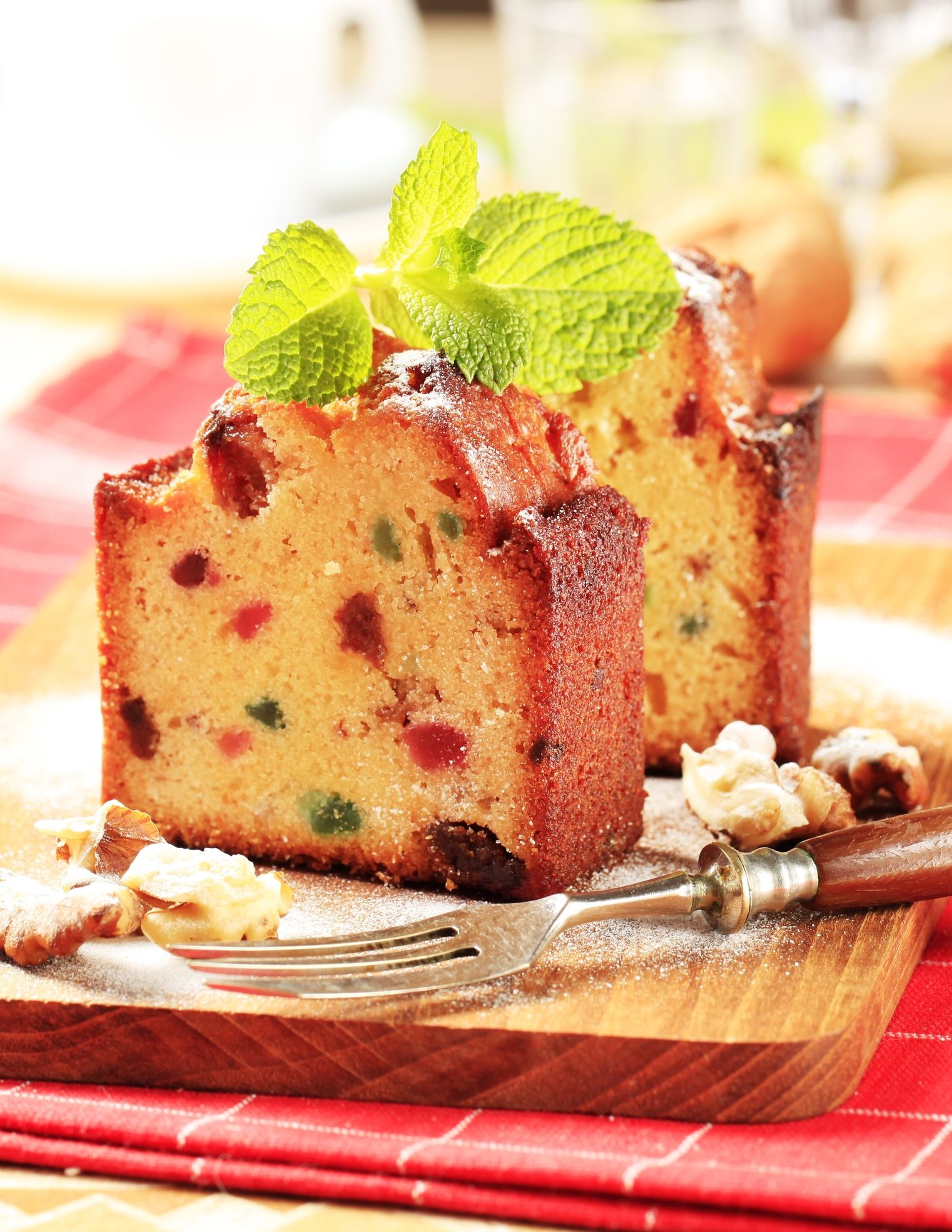Love it or hate it, fruitcake is one of Christmastime’s most iconic foods. I make no apologies for being one who loves it, and over the years I’ve amassed quite a collection of recipes from sources near and far. While we might credit our Irish mother or grandmother with carrying on the holiday fruitcake-making tradition, we can look even further into history to uncover its possible origin.
Ancient Egyptians left fruit-and-nut cakes in graves, the theory being that they would provide sustenance in the afterlife. Romans mixed raisins, pine nuts, pomegranate seeds, and honeyed wine into barley cakes to feed soldiers. The cakes had a long shelf life and were incredibly portable, making them a perfect food for extended military campaigns. Starting in the 1400s, prized dried and preserved fruits and nuts were traded westward from the Middle East to Europe where they were baked into cakes. Due to the exotic and expensive cost of these ingredients, fruit and nut baked goods were reserved for special occasions, particularly Christmas, and they became very popular in England where Victorians loved to have fruitcakes with their tea (don’t we all?) Queen Victoria’s wedding fruitcake, in fact, cemented its popularity, with other royals and commoners alike serving it at their weddings. In eighteenth-century Europe, fruitcake was eaten around the winter solstice to mark the annual nut harvest, again making the cakes popular at Christmastime.
Dyed red and green glacé cherries, candied/preserved pineapples, lemons, and oranges sweeten and moisten fruitcakes, lend festive color, and “feeding” the cakes with rum, brandy, or whiskey helps to preserve them (the alcohol kills bacteria and prevents mold). Aged fruitcakes can last for 6 to 12 months in the refrigerator. Fruitcake-deniers often associate their distaste with the dark varieties that include molasses, brown sugar, and black fruits like currants and dates, so I would advise rethinking that position with one of these light cakes. These are generally meant to be eaten before they’ve aged and are made with granulated sugar, golden and yellow fruits, and candied fruit and peel. For both dark and light recipes, have a look at my Festive Flavors of Ireland cookbook that contains both. Signed copies are available at irishcook.com.

TEA TIME FRUITCAKE
Makes 1 loaf
One of Ireland's finest hotels, Dromoland Castle in County Clare is among the few castles that can trace its ownership back through history to Irish families of royal heritage. This signature fruit cake, served at Mrs. White’s Afternoon Tea, would be a delicious addition to your own teatime or to a holiday event. Be sure to start the preparation at least two days before you want to serve it to let the fruits soak and the flavors meld.
1 cup water
1 cup raisins
1 cup golden raisins
2 ounces candied red cherries
1 1/2 tablespoons dark rum
1 1/2 tablespoons sherry
1 teaspoon vanilla extract
4 ounces unsalted butter, at room temperature
1/2 cup sugar
2 large eggs
1cup self-rising flour
1 teaspoon pumpkin pie spice or Mixed Spice (see Note)
Softened butter, for serving
1. In a medium saucepan, bring water to a boil. Stir in raisins, golden raisins, and cherries; cook for 2 to 3 minutes. Drain the fruit; transfer to a small bowl. Stir in the rum, sherry, and vanilla. Cover; let stand at room temperature overnight.
2. Preheat the oven to 300°F. Coat a 9-inch loaf pan with no-stick baking spray with flour.
3. In a large bowl, beat the butter and sugar with an electric mixer on medium speed until light and fluffy. Beat in the eggs, one at a time, beating well after each addition. With a wooden spoon, fold in the flour and pumpkin pie or Mixed Spice. Stir in to the fruit mixture. Transfer to the prepared pan
4. Bake the loaf for 60 to 75 minutes, or until a skewer inserted into the center comes out clean. Let cool completely on a wire rack. Remove loaf from pan; wrap in foil. Leave overnight before cutting into slices. Serve spread with butter, if desired.
Bushmills Boiled Fruitcake
Makes 1 large or 4 to 5 small loaves
This fruitcake, which has been in my collection of recipes for two decades, is an interesting one. The dried and candied fruits are cooked with butter, brown sugar, and crushed pineapple before being mixed with the dry ingredients, a technique that produces a very moist cake.
1 (20-ounce) can crushed pineapple, undrained
4 ounces butter
1/2 cup (packed) light brown sugar
2 cups golden raisins
1/2 cup candied cherries, chopped
1/2 cup fruit and peel mix
2 cups all-purpose flour
1 teaspoon baking soda
1 1/2 teaspoon baking powder
1/2 teaspoon salt
1 teaspoon pumpkin pie spice or Mixed Spice (see Note)
2 large eggs, beaten
2 to 3 tablespoons Bushmills Irish whiskey, for drizzling
1. In a large saucepan, bring the pineapple, butter, sugar, raisins, cherries, and mixed peel to a boil. Cook, stirring continuously, for 5 minutes. Remove from the heat; let cool completely.
2. Preheat the oven to 325°F. Coat a 9-inch loaf pan, or 4 to 5 (3-inch) mini loaf pans, with no-stick baking spray with flour.
3. In a large bowl, whisk together the flour, baking soda, baking powder, salt, and pumpkin pie spice or Mixed Spice. With a wooden spoon, stir into the fruit mixture; stir in the eggs. Spoon the mixture into the prepared pan(s).
4. Bake the large cake for 60 to 75 minutes (test with a skewer at 55 minutes), or mini loaves for 50 minutes.
5. Let cakes cool on a wire rack for 10 minutes. Prick top of cake(s) in several places; drizzle with whiskey while still warm.Remove cake(s) from pan; let cool completely. Wrap in plastic wrap; store in an airtight container for up to 4 weeks or freeze.
Note: To make Mixed Spice, combine 1 tablespoon coriander seeds, 1 crushed cinnamon stick, 1 teaspoon whole cloves, and 1 teaspoon allspice berries in a spice or coffee grinder. Process until finely ground. Stir in 1 tablespoon nutmeg and 2 teaspoons ginger. Store in an airtight container.
Margaret Johnson’s “Recipes” page now includes “Ireland Hopping: Adventures in Food, Drink, and Travel.” For further details on her work, including how to order her cookbooks, click here.









